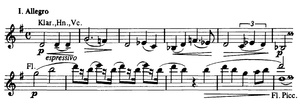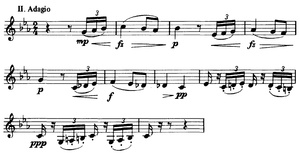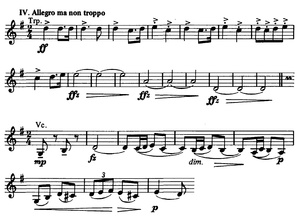8th Symphony (Dvořák)
The Symphony No. 8 G major op.. 88 ( B 163) is a symphony of the Czech composer Antonin Dvorak . During the composer's lifetime it was counted as his 4th symphony.
Emergence
Dvořák wrote the symphony in 1889 on the occasion of his, as he noted on the title page of the score, "admission to the Bohemian Emperor Franz Joseph Academy for Science, Literature and Art". The 8th symphony forms a relaxed, lyrical contrast to the gloomy mood of Dvořák's 7th Symphony . Dvořák was inspired by the landscape near Vysoká u Příbramě , his summer residence, for the composition, with which Dvořák set himself the goal of “writing a work that differs from my other symphonies, with individual thoughts that have been worked out in a new way” . The first performance took place on February 2, 1890 in Prague under the direction of the composer.
To the music
occupation
2 flutes (2nd also piccolo ), 2 oboes (2nd also English horn ), 2 clarinets , 2 bassoons , 4 horns , 2 trumpets , 3 trombones , tuba , timpani and strings .
1st movement: Allegro con brio
The first set is of a choral-like G minor issue in cello , clarinet and bassoon initiated, still more times at the beginning of the course of the set exposure , implementation and recapitulation is repeated. The actual main pastoral theme is in G major and performed by the flute. After an intensification of the theme by the orchestra, the secondary theme follows. Before the development, the G minor theme is repeated, which sounds in the trumpet before the recapitulation. At the beginning of the recapitulation, the G major theme sounds again in the woodwinds and ends in minor.
2nd movement: Adagio
The second movement is a rhapsody-like adagio in C minor and 2/4 time and influenced by Pyotr Ilyich Tchaikovsky , with whom Dvořák had become friends shortly before. It begins melancholy, but is continued by a fourth in the flute, similar to a bird's call. The continuation of the melancholy beginning in the deep clarinet alternates with the fourth. In the middle part of the movement follows a sweeping C major theme, which is taken up by the solo violin. The movement is characterized by a juxtaposition of light and dark, C major and C minor alternate.
3rd movement: Allegretto grazioso
The third movement begins with a delicate and waltz-like theme in G minor in the violins. The main part is followed by a G major trio, the melody of which is carried by the flutes and oboes. The graceful three-eighth time is also retained in the trio. In the repetition of the trio, the theme is then heard in oboe and bassoon. While most of the movement is in odd time, the coda is played in even time. The waltz-like style of this movement is possibly an expression of the composer's preoccupation with Pyotr Tchaikovsky's music at the time.
4th movement: Allegro ma non troppo
The fourth movement is in G major; in it the sonata form is combined with variations . It is introduced by a trumpet fanfare in D. Then the two-part variation theme is introduced by the cellos . A horn trill and a virtuoso flute melody characterize the first variations. The subsequent distinctive, rhythmic third variation is called "Slavonic Variation". A lyrical passage finally leads to the virtuoso coda of chromatic character, which gives the work a triumphant ending.
effect
The premiere conducted by Dvořák himself on February 2, 1890 in Prague with the orchestra of the Czech National Theater as part of the »13. Popular Concerts of Artists Resource «was another success for the composer. Further performances by Dvořák took place on November 7, 1890 in a museum concert in Frankfurt am Main and the following year in Cambridge, England, on the eve of his doctorate. During Dvořák's sixth trip to England, the symphony was performed several times by the Royal Philharmonic Society . Hans Richter premiered the symphony in Vienna and London and after the Vienna performance wrote to Dvořák: “You would certainly have enjoyed this performance. We all felt that it was a wonderful work: that is why we were all enthusiastic about it. [...] The applause was warm and hearty. "
Dvořák had the work published by the London publisher Vincent Novello and not with his regular publisher Fritz Simrock , as he was still at odds with him over the printing of the 7th Symphony .
Since this symphony was printed in England, there were only relatively few performances in Germany and Austria after 1919. Presumably some orchestras were too expensive for the sheet music because there was a lack of foreign currency everywhere. In other countries this work quickly became part of the 'Iron Repertoire'. It was not until May 1941 that a new edition (score and parts) carefully edited by Fritz Oeser appeared in the Musikwissenschaftlichen Verlag / Leipzig. (Oeser did not have the manuscript available and - due to the war years - no access to London sources. However, he succeeded in eliminating many careless mistakes in the - actually quite solid - first edition.) This neat, very cleanly engraved new edition is still often used today and has made the work better known in the German-speaking world.
In 1956 this work appeared again as part of the first Dvořák Complete Edition (ed. Otakar Šourek and František Bartoš). The editors also took over corrections and conjectures from Fritz Oeser, with whom they were both friends, including the drum bars of the 4th movement that he added by analogiam, which were missing in the first edition. (Bars 100 - 108). Nevertheless, the source situation remains somewhat difficult in terms of small details (slurs, dynamics, accents, missing open bars, etc.), since it was not the manuscript but a copy from the Novello publishing house that was used for printing, which was only saved in 1964. However, the new editors were not able to clarify which version would be preferred in individual cases. Various retouching has also become established, such as the support of the woodwinds (4th movement from bar 158 and from bar 380) with horns.
The 8th symphony is one of the most played Dvořák symphonies today and, along with the 7th and 9th symphonies, is one of the master's most important symphonic creations. George Szell and Vacláv Talich have made impressive recordings.
literature
- Hansjürgen Schaefer: Concert Book Orchestermusik AF, VEB Deutscher Verlag für Musik, Leipzig 1958
- Alfred Beaujean in: Lexicon Orchestermusik Romantik , ed. von Wulf Konold, Munich: Piper 1989, Vol. 1, pp. 205-208
- Christoph Hahn, Siegmar Hohl (eds.), Bertelsmann Konzertführer , Bertelsmann Lexikon Verlag, Gütersloh / Munich 1993, ISBN 3-570-10519-9
- Harenberg concert guide, Harenberg Kommunikation, Dortmund, 1998, ISBN 3-611-00535-5
Web links
- 8th Symphony (Dvořák) : Sheet music and audio files in the International Music Score Library Project




